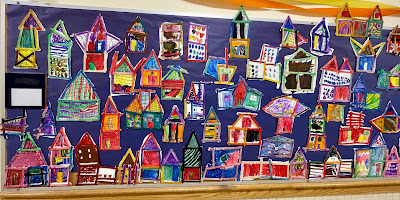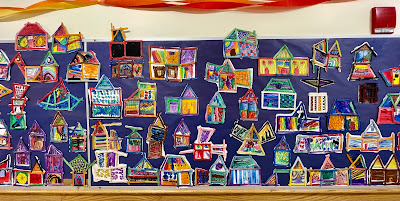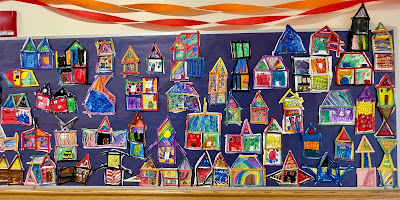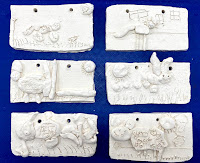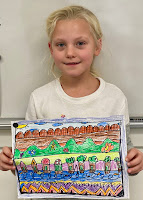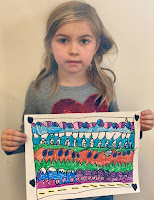We looked at different styles of artwork including; Abstract, Non-Objective and Realistic. We also talked about the difference between Folk Art and Fine Art. We then looked at a collection of Heather Galler's (a New York Folk Arist) paintings and talked about what we saw. Observations included: lots of color, shapes, and patterns.
Monday, January 10, 2022
Folk Art Landscape
Tuesday, October 5, 2021
Starting off the year with Art
 |
| "Just make a mark and see where it takes you" The Dot, by Peter H. Reynolds |
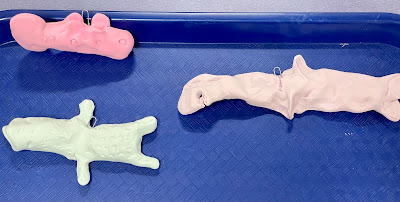 |
| You Be You, By Linda Kranz. |
Thursday, June 3, 2021
Thursday, May 13, 2021
Architecture
Rowe artist learned about what an Architect does and looked at some famous examples of architecture including The Dome of the Rock, Notre Dame, Falling Water, The Dancing House, The Golden Pavilion, and St Basil's Cathedral. We then got to work building our own building frames out of craft sticks. The buildings could be traditional or creative.
Here are some examples of the steps so far.
Thursday, March 11, 2021
Animal Unit
 Rowe artists are working on using their "artist eyes" to break animals down into shapes in order to learn to draw what they see.
Rowe artists are working on using their "artist eyes" to break animals down into shapes in order to learn to draw what they see.
The lesson started by practicing drawing at least 2 animals by looking at pictures from the book ZooOlogy. The artists will then pick one animal to draw for a final piece of art.
An additional part to this animal unit is creating a Relief sculpture tile out of clay. We talked about the difference between 2-dimensional drawings and 3-dimensional sculptures. These sculptures will come home with two holes at the top so they can be hung on the wall.
Thursday, February 4, 2021
Block Printing
 |
| A print from each Rowe artist is hanging in the hallway. |
Tuesday, December 15, 2020
Monoprinting and Wrapping pinch pots
Rowe artists practiced making monoprints using tempera paint and then used them to wrap up their pinch pots to take home.
Sunday, December 13, 2020
Colorful Pots and Yayoi Kusama
 |
| Kindergarten Painted Pots & First Grade Glazed Pots |
We learned about Japanese artist, Yayoi Kusama by reading Yayoi Kusama Covered Everything in Dots and Wasn't Sorry. We used her dot style to paint our pots in first grade and make wrapping paper in Kindergarten.
Monday, November 30, 2020
Pinch Pots
We learned about two traditional potters: Juan Quezada, by watching a reading of The Pot That Juan Built and Maria Martinez, by watching a few clips from a documentary.
We then learned the steps to create a pinch pot.
Kindergarten artists were able to turn the pinch pots into any shape.
First-grade artists will be using glaze and therefore their pots were made into bowls or drinking cups.
Friday, November 20, 2020
Thursday, October 15, 2020
Printmaking, Texture, and Creative Trees
Continuing with our talks about the Elements of Art we learned more about Lines, Pattern and introduced Texture.
Some classes worked on printmaking with leaves and paint. We talked about how the bumped up texture of the veins of the leaves made it so we could make prints.
We also talked about how artists use pattern to add Texture and detail. Students were able to use sharpies to add pattern to pre-printed leaves to show more texture.
We learned the difference between texture and visual texture and talked about how artists use line, pattern and color to show visual texture.
Monday, October 5, 2020
Inspiration
The first few classes this year have focused on the Elements of Art including Color, Line & Pattern. We also discussed just making your mark and getting started, Inspiration, and color mixing.
We watched a read-aloud of The Dot, by Peter Reynolds, and then made our marks on large white dots of color diffusing paper with Primary color markers (red, yellow & blue). We then talked about color mixing and used droppers to add water to our colorful dots to watch the Primary colors mix into the Secondary colors.
Tuesday, March 10, 2020
Tjanpi Desert Weavers
 These artists use materials collected from the lands around them to create beautiful baskets and animal sculptures.
These artists use materials collected from the lands around them to create beautiful baskets and animal sculptures. After seeing a few examples of their work we experimented with pipe cleaners and yarn to create our own mini animal sculptures.
After seeing a few examples of their work we experimented with pipe cleaners and yarn to create our own mini animal sculptures.Tuesday, March 3, 2020
Learning about Depth
We discussed that our paintings had a foreground, middle ground, and background.
We finished the mountainscapes by printing a moon and using a pipette to add a snowstorm.
Tuesday, February 11, 2020
Friday, January 31, 2020
Colorful Chalk Cityscapes with Printed lines
 Before the break, we learned about different types of lines, for this project we discussed how lines go together to make shapes. We learned that everything is made out of shapes and lines. We then read the book Wow! City!, by Robert Neubecker and looked at a few Cityscapes by Paul Klee, James Rizzi, and Brian Whelan and talked about the shapes we see the most of in a city and what types of lines make those shapes.
Before the break, we learned about different types of lines, for this project we discussed how lines go together to make shapes. We learned that everything is made out of shapes and lines. We then read the book Wow! City!, by Robert Neubecker and looked at a few Cityscapes by Paul Klee, James Rizzi, and Brian Whelan and talked about the shapes we see the most of in a city and what types of lines make those shapes. Sunday, December 22, 2019
Tuesday, November 26, 2019
Thursday, November 14, 2019
Taking a Line for a Walk
Tuesday, November 5, 2019
Lines
To start this unit the students were given a base and a handful of colorful lines (strips of paper)
and were tasked to create a 3-dimensional sculpture from the 2-dimensional lines.



